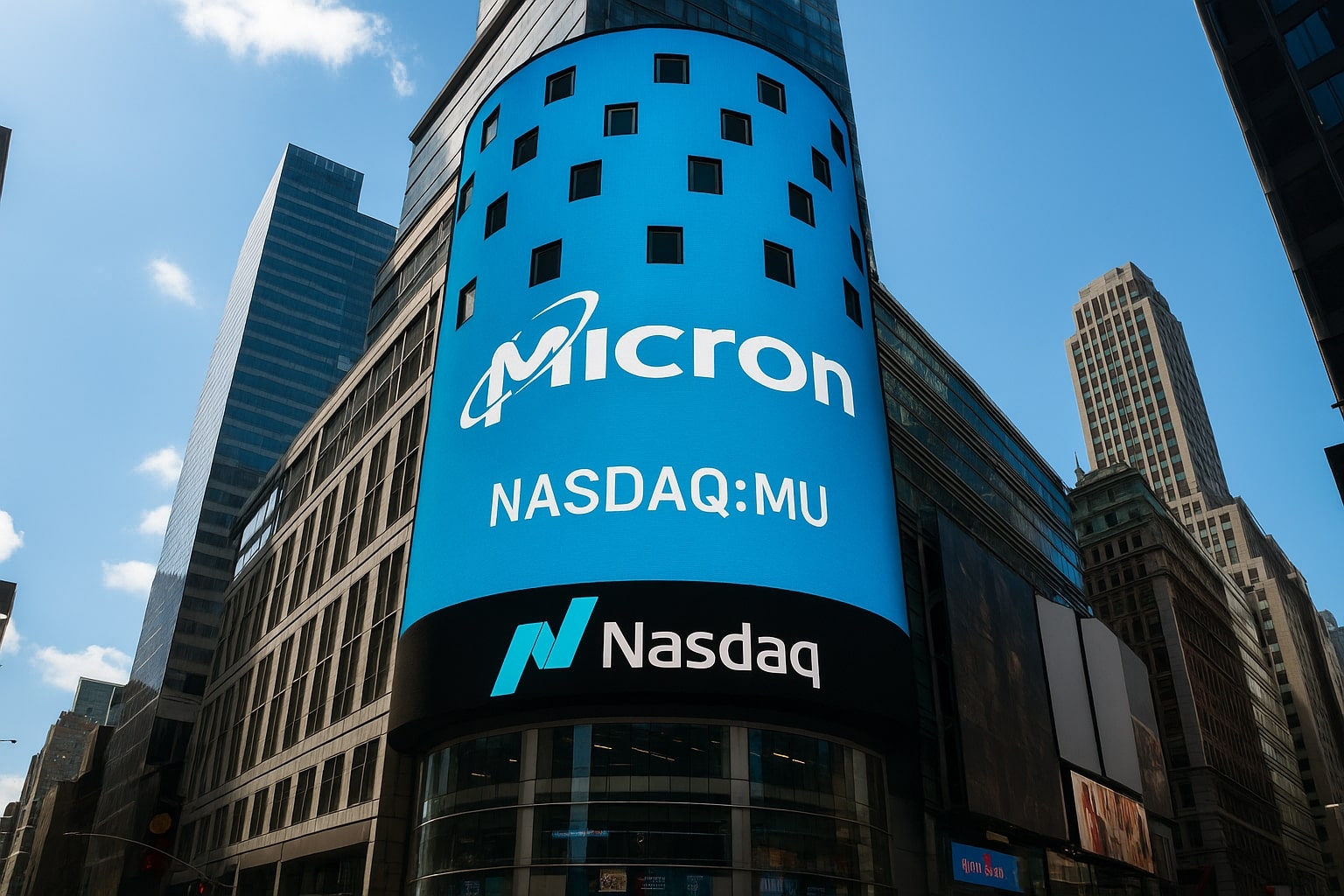
Micron Stock Forecast: NASDAQ:MU Surges on AI Memory Demand and Raised Guidance
HBM growth, 600% EPS surge, and stronger DRAM pricing drive Micron’s outlook as NASDAQ:MU gains momentum with AI demand | That's TradingNEWS
NASDAQ:MU Rides AI Wave With Strong Memory Demand and Upgraded Forecasts
Micron Technology Inc. NASDAQ:MU has emerged as one of the most aggressively bid names in the semiconductor sector, with its stock trading around $122 and carrying a market capitalization near $133 billion. The performance reflects a remarkable 41.4% YTD rally and a 25.5% gain year-over-year, comfortably outpacing benchmarks like the Dow Jones Industrial Average, which rose only 10.8% over the same stretch. Recent quarterly reports have reshaped sentiment: fiscal Q3 2025 revenue surged 37% year-over-year to $9.3 billion, while adjusted EPS jumped 208% to $1.91. Guidance for fiscal Q4 has been raised to $11.2–$11.3 billion in revenue with EPS expected at $2.57–$2.71, a significant increase from earlier forecasts of $2.14–$2.44.
AI and High-Bandwidth Memory Transform Micron’s Growth Outlook
The surge in AI workloads is reshaping Micron’s position in the global memory market. Its high-bandwidth memory (HBM) products are the cornerstone of this growth. Analysts project Micron’s HBM revenues will surpass $6 billion in run-rate by year-end 2025, with potential to exceed $10 billion shortly after. Gross margins on HBM have been reported in the 50–55% range, far higher than traditional DRAM or NAND, providing Micron a profitability engine that is unmatched in its history. With expectations of capturing up to 20% of global HBM market share, Micron is positioning itself as a core supplier for AI accelerators and data center customers in competition with Samsung and SK Hynix.
Strength in DRAM, Stabilization in NAND, and Cyclical Recovery
Beyond HBM, the company’s DRAM business, which still accounts for the majority of sales, has shown encouraging recovery. DRAM spot prices, particularly DDR5, have firmed in 2025, supported by demand from server and AI clients. NAND remains a drag, with pricing pressure and oversupply capping profitability. However, management signaled that NAND conditions may have bottomed out in spring 2025, with improvement forecasted for late 2025 into 2026. Analysts expect NAND to benefit from enterprise SSD adoption as suppliers restrain spending. The combination of DRAM resilience, HBM profitability, and eventual NAND recovery sets Micron on a balanced growth trajectory.
Financial Health, Margins, and Analyst Revisions Drive Confidence
Micron’s fundamentals highlight a transformed business model. Over the last twelve months, revenue expanded 58.2%, EBITDA stood at $15.7 billion, and the company maintained a current ratio of 2.75, signaling liquidity strength. Net margins have improved to 22.18%, operating margin sits near 27%, and gross margin remains above 43%. Analysts’ consensus EPS for fiscal 2025 has risen sharply to $8.04, a +518% increase from last year’s $1.30, with 19 analysts revising estimates higher in recent weeks. Projections for fiscal 2026 call for EPS between $11.47 and $14.62, positioning Micron for sustained double-digit earnings growth.
Valuation and Relative Multiples Put Stock in Focus
At its current price, Micron trades at a forward P/E of about 15x, far below AI peers trading at multiples exceeding 100x earnings. The valuation discount is notable when juxtaposed with NVIDIA (NASDAQ:NVDA), which trades at far loftier levels. Micron’s PEG ratio sits near 4.13, while EV/Sales at 115x appears high because of cyclical revenue but is underpinned by improving profitability. Analysts’ mean price target is $152.50, representing an upside of 28% from current levels, while some bullish estimates point toward $155–$160 if guidance continues to be surpassed.
Insider and Institutional Positioning Reflects Confidence
Institutional interest has remained strong, with over 57% of shares held by funds, reflecting confidence in Micron’s strategic pivot toward AI-driven products. Insider activity can be tracked here. While insider sales have been limited compared to other tech peers, the balance between insider behavior and institutional accumulation highlights that the market still views NASDAQ:MU as an undervalued way to play AI demand without paying excessive valuations.
Risks From Cyclicality and Competitive Pressure Remain
Despite the bullish setup, risks are significant. Micron remains exposed to the classic memory cycle, where oversupply or rapid capacity additions by rivals can crush pricing power. Competitors like Samsung and SK Hynix remain aggressive in qualifying new HBM generations with customers such as NVIDIA. If Samsung’s HBM4 secures faster traction, Micron’s market share gains could stall. Moreover, free cash flow, at about one-third of reported net income, remains weaker than earnings, raising questions about how much of the profitability is translating into cash returns.
Verdict on NASDAQ:MU
Micron has undergone a fundamental transformation from a cyclical memory provider into a cornerstone of the AI infrastructure supply chain. Trading at $122 with earnings expected to climb over 600% year-over-year, Micron is generating growth numbers usually reserved for high-multiple software firms yet trades at only 15x forward earnings. Its AI-driven HBM growth, stabilization in DRAM, and recovery in NAND make it one of the few semiconductor stocks where valuation still lags fundamentals. With upgraded guidance, stronger-than-expected margins, and rising analyst revisions, NASDAQ:MU stands as a Buy despite cyclical risks. The stock offers a compelling mix of secular AI tailwinds and relative undervaluation, positioning it as one of the most attractive plays in the semiconductor space today.
That's TradingNEWS
Read More
-
AbbVie Stock Price Forecast - ABBV at $229 Turns the Humira Cliff Into a 2026 Growth Engine
02.01.2026 · TradingNEWS ArchiveStocks
-
XRP Price Forecast - XRP-USD Nears $2 as $1.80 Support and Shrinking Supply Point to $2.60 Target
02.01.2026 · TradingNEWS ArchiveCrypto
-
Oil Price Forecast - Oil Slide Into 2026: WTI Stuck at $57, Brent at $60
02.01.2026 · TradingNEWS ArchiveCommodities
-
Stock Market Today: Nasdaq Hits 23,467 as Nvidia (NVDA), Micron (MU) and Baidu (BIDU) Drive AI Surge
02.01.2026 · TradingNEWS ArchiveMarkets
-
GBP/USD Price Forecast: Pound Holds 1.3450 as Fed–BoE Split Keeps Bulls Aiming at 1.37
02.01.2026 · TradingNEWS ArchiveForex


















